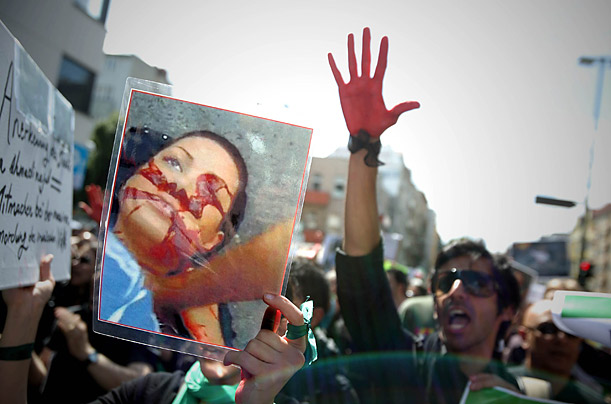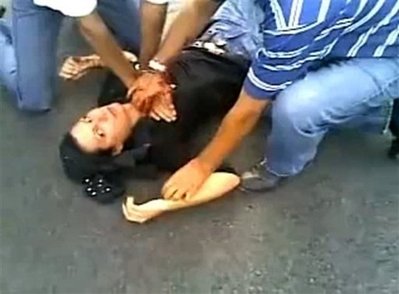I drove into a Westwood parking garage late on Monday and saw that the attendant had been crying. After an uneasy moment–I wasn’t sure where compassion and polite distance met in a situation like this–I asked, “Are you okay?” It’s such a disingenuous question but it seems to work when you want to say, “I give a damn.” The attendant half-smiled and averted her eyes in a way that made me think she wouldn’t answer. When she handed me my change, however, she said, “My mother died.” I don’t know what I expected, but that wasn’t it. “No!” I exclaimed. “You shouldn’t even be here.” I wish I hadn’t said that. How do I know where she should or shouldn’t have been? I don’t know anything about her or her pain. All I know is that, in general, death hurts.
Tuesday night, an event at UCLA’s Hammer Museum dealt with death in a way that was less discriminating than I would have liked. The Museum joined forces with PEN USA to present a reading titled, “I Am Neda.” The event promised to bring together dissident poets and to celebrate freedom fighters in Iran. I went because, like so many others, I found the video of Neda Agha-Soltan, the unknown makers of which just received a George Polk Award for Videography, emotionally searing. I also went because the Neda phenomenon seems so heavily visual that I wanted to see how poetry could claim her image.
The Neda video that went viral on June 20, 2009, showed a young woman, shot through the chest during a protest, dying with renegade grace. When she fell, her legs bent and flopped tom-boyishly, seemingly disregarding the mores of a propriety-obsessed society, and her loosely-fisted hands slowly collapsed to frame her blood streaked face. All of this made her an easy symbol for freedom. She was also young and attractive, so her photograph translated well to signs and posters that started appearing in the days following her death. International correspondents began calling her “the face of a revolution” and the “voice of freedom.” She was an icon before anyone actually knew who she was or what she had been doing on the day she died.
I was hoping that the poets at the Hammer would break into this blind collectivism and make the Neda phenomenon more localized, more particular. To an extent, they did. Poet Eloise Klein Healy, like many of the others featured, did not speak to Iran directly. Instead she spoke of George Washington. “There is no cherry tree,” she began. “There is mud and blood and winter.” Healy portrayed Washington as endearingly unpretentious: “There is a letter in which he orders a uniform he designed himself. It does not fit very well because he does not know his size. He wears it anyway. Democracy.” So this is freedom: something we try our best to design for ourselves, something we’re responsible for even though we don’t quite understand how it works. A poem by Joy Harjo, read in absentia, suggested that legacies of injustice tend to rear up uninvited: “I want to have a good time and would rather not speak with history over my plate of fish and catch up. But history came to me.”
However, the event’s centerpiece, Sholeh Wolpe’s poem “I Am Neda,” read in English and Persian and sung by Iranian vocalist Mamak Khadem, opted for drama over thoughtful discretion. Wolpe’s poem began, “Leave the Basiji bullet in my heart,/fall to prayer in my blood,/and hush, father/– I am not dead.” A video projection accompanied Khadem’s performance and when Khadem sang the words, “I am not dead,” a stately young woman, dressed in a romantically flowing skirt, got up from where she’d been lying on the ground and began to dance. The poem continued, “More light than mass,/I flood through you,/breathe with your eyes,/stand in your shoes, on the rooftops,/in the streets, march with you.”
What good does it do Neda to be “more light than mass”? Bodies are supposed to have mass. That Neda wasn’t allowed to keep her mass, to physically continue being, is the real outrage. The rest–the flooding light, the solidarity, the voice of freedom–has been posthumously forced onto her.





